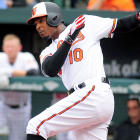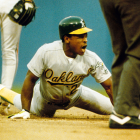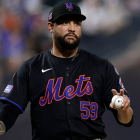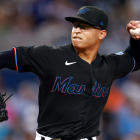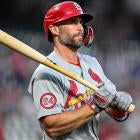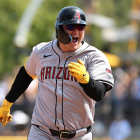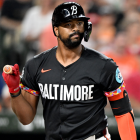The Baltimore Orioles could be the majors' busiest team between now and the July 31 trade deadline. The O's are expected to deal a number of mainstays, including shortstop Manny Machado and relievers Zach Britton and Brad Brach. Center fielder Adam Jones hasn't surfaced in many rumors, but this week he was brought up in connection with the Cleveland Indians.
Jonah Keri discussed that piece of speculation on CBS Sports HQ (watch live here), questioning why Cleveland would pursue Jones when they could theoretically get equal (or better) production from a different player who would cost less to acquire. Fair enough.
Because Cleveland is regarded as one of the sport's savviest organizations, we wanted to examine the rumor from another angle: is there reason to think Jones is a better get than previously thought?
We came up with three reasons why Cleveland (and other teams) might believe so.
Reverse splits
Our Matt Snyder recently sifted through the outfielders likely to be available on the trade market and found many of them wanting. Getting an everyday or most-days starter, a worthwhile one anyway, is going to be tough for teams in need. Jones might be one of the few available, however, and it's due in part to his odd platoon splits.
Typically a right-handed hitter with a sizable platoon split is not classified as a "most-days starter." Jones is because he's a better hitter versus right-handed pitchers (career .793 OPS) than left-handed pitchers (.727). There's no sign of the trend correcting itself, either. In fact, Jones has been consistent against righties, posting at least a .790 OPS against them in every season but one since 2009. (He's at .739 so far this year, or 10 points shy of the average lefty's OPS against right-handed pitching.) Versus lefties, he's finished at .750 or below in OPS in each of the past three seasons, and currently sits at .680 -- that despite a .301 average.
Any team who believes Jones's splits are predictive rather than descriptive for whatever reason -- maybe he's just more comfortable against righties, or he's better at recognizing breaking balls than changeups -- could slot him into their lineups most days with comfort. Heck, they could even pair him with a lefty-mashing righty to form a quality platoon, as odd as that sounds.
Defense?
The toughest sell on Jones is figuring out where he should play defensively. His reputation in center field has always outpaced his metrics, as he's won four Gold Glove Awards throughout his career, including his most recent in 2014. While defensive metrics are notoriously unreliable, they have Jones down for being worth about negative-40 runs since the start of the 2016 season. Even if that's too harsh by half, Jones is still more of a liability than an asset in center.
A team like Cleveland has likely delved into his Statcast data to figure out whether he would benefit from a shift to left or right field and some potentially improved positioning.
The data that is available to the public shows that Jones has slowed over the past several seasons. Whereas he ranked in the league's top 75 percent in sprint speed a few years back, he's now in the bottom half. His raw sprint speed places him among names like Evan Gattis, Jefry Marte, and Freddie Freeman -- or three players who never, ever would be allowed in center field. The only center fielder with a worse sprint speed than Jones is Odubel Herrera.
All the same, the Orioles have played Jones more shallow than the average center fielder. As a result, Jones has been particularly poor on balls hit deep. According to Baseball Info Solutions, he's scored a minus-11 on "deep" balls, as opposed to a minus-7 on balls hit shallow. Asking Jones to take a few steps back would likely result in more singles falling in, but it could also help him take away some extra-base hits. That's a trade that a team like Cleveland, whose pitching staff is so adept at striking out batters, would probably make in most situations -- and one that would make his glove more tolerable in context, and likely in a vacuum.
Intangibles
Maybe we're stretching here, but there's something to be said about Jones being a well-liked and well-regarded clubhouse presence. At minimum, he's not going to cause a disruption with his new team. Given how protective teams are of such things, that could work in his favor, especially for younger teams hoping to add a positive veteran presence.
Is Jones a defensive dynamo who deserves to bat third or fourth in a lineup? No, not anymore. But he can be a league-average hitter who thrives without the platoon advantage and who might be tolerable at defending a corner spot. His name outweighs his value, sure, but his skill set and personality are not without charm.
Within the context of the outfield market as a whole, it's understandable why teams like Cleveland are considering adding Jones for the stretch run.








